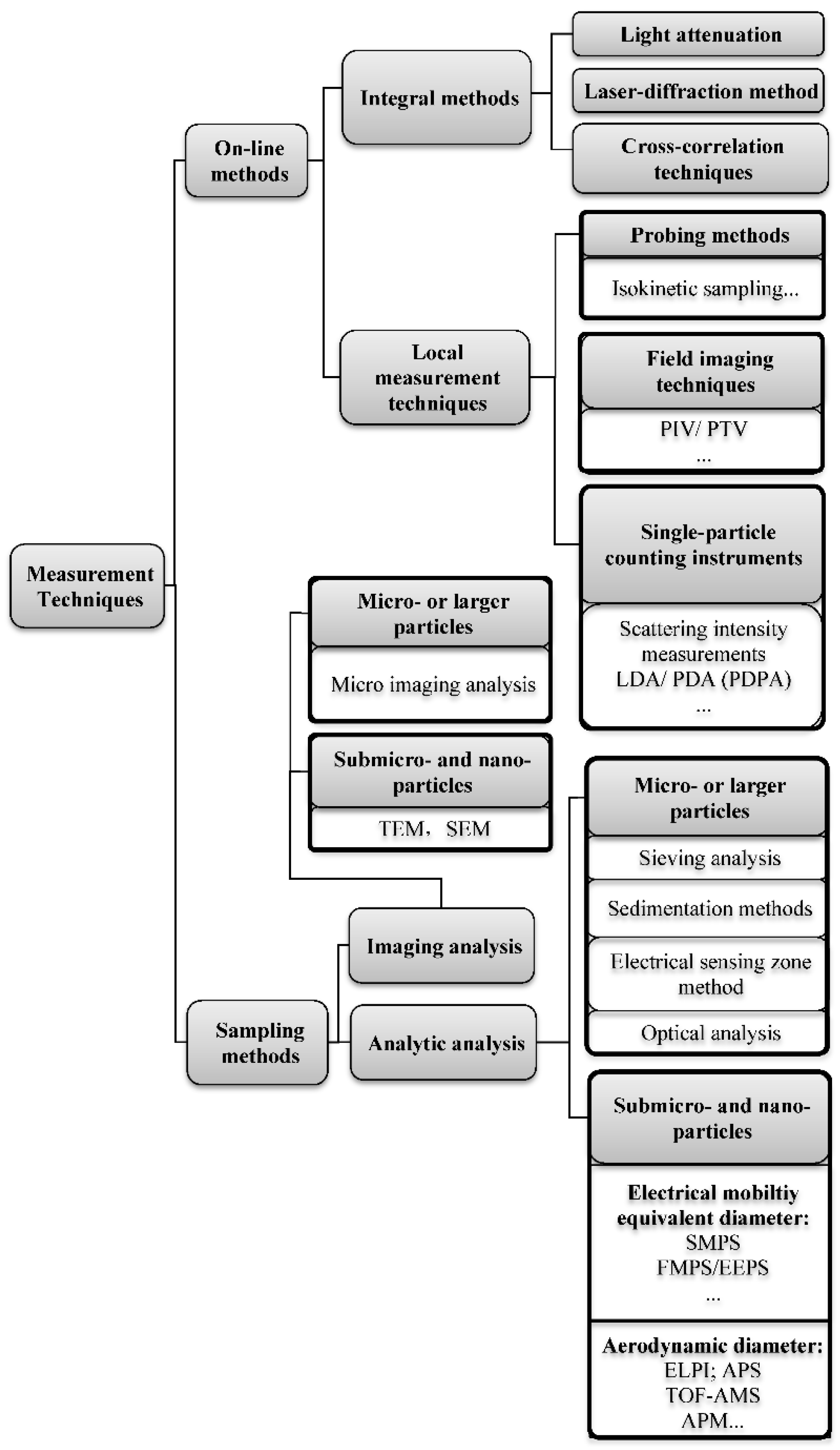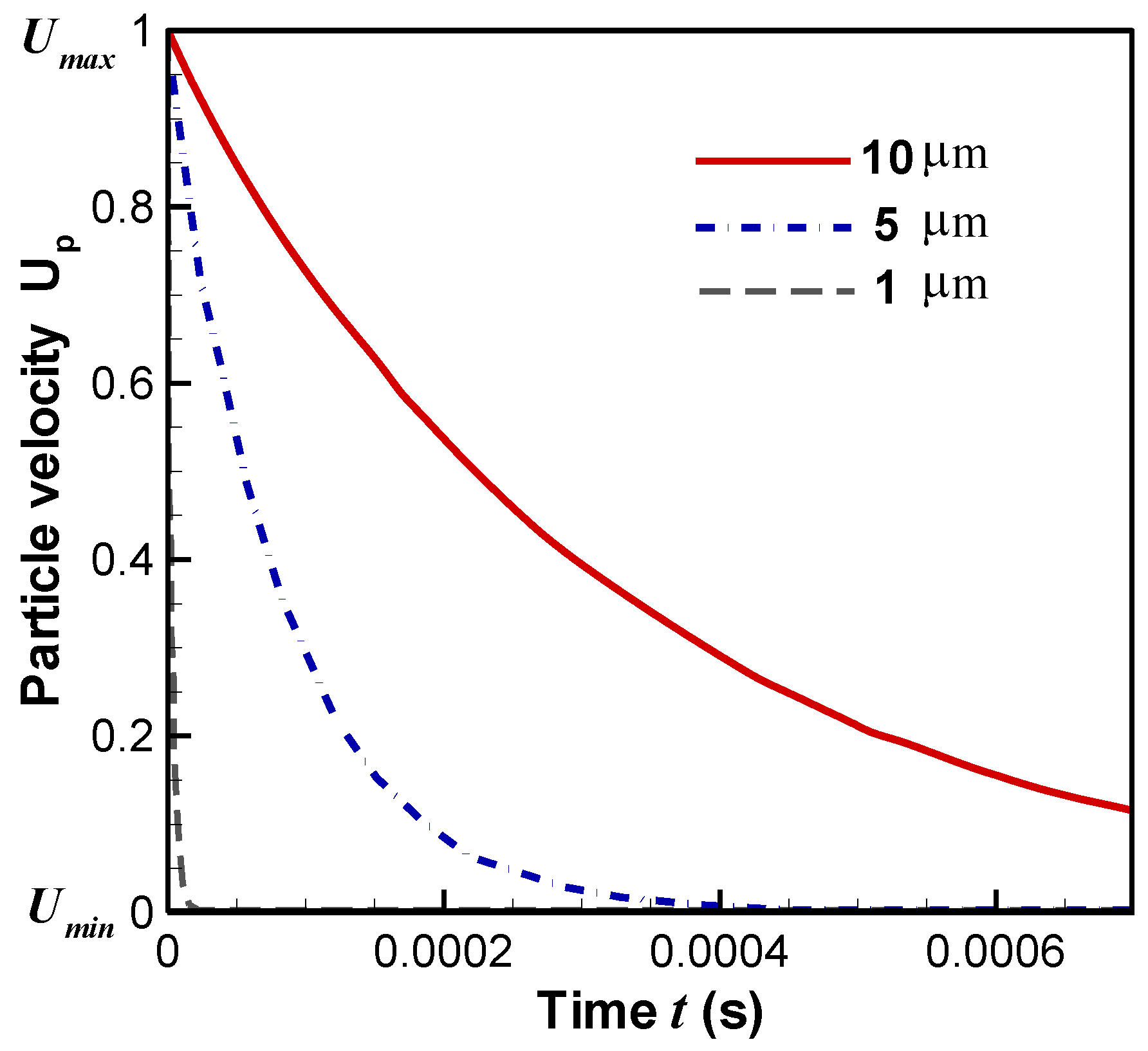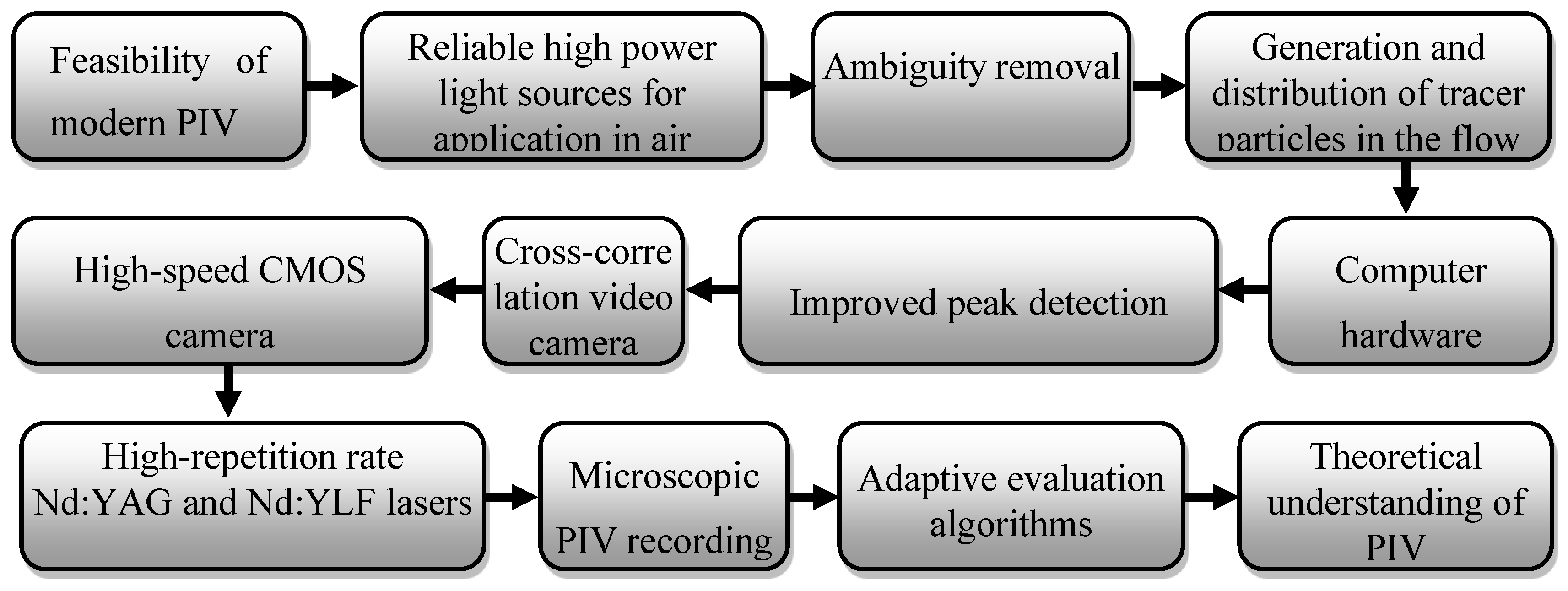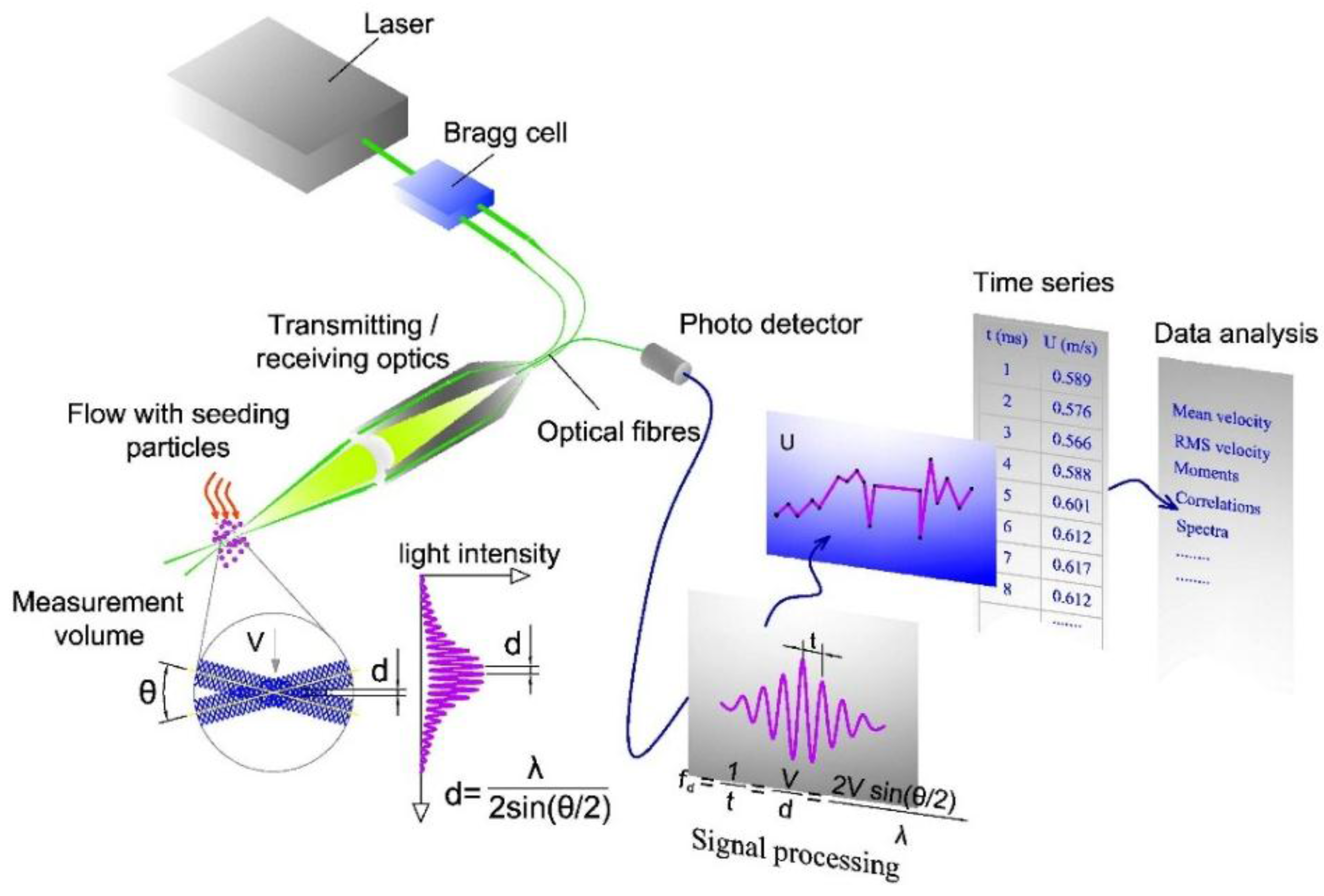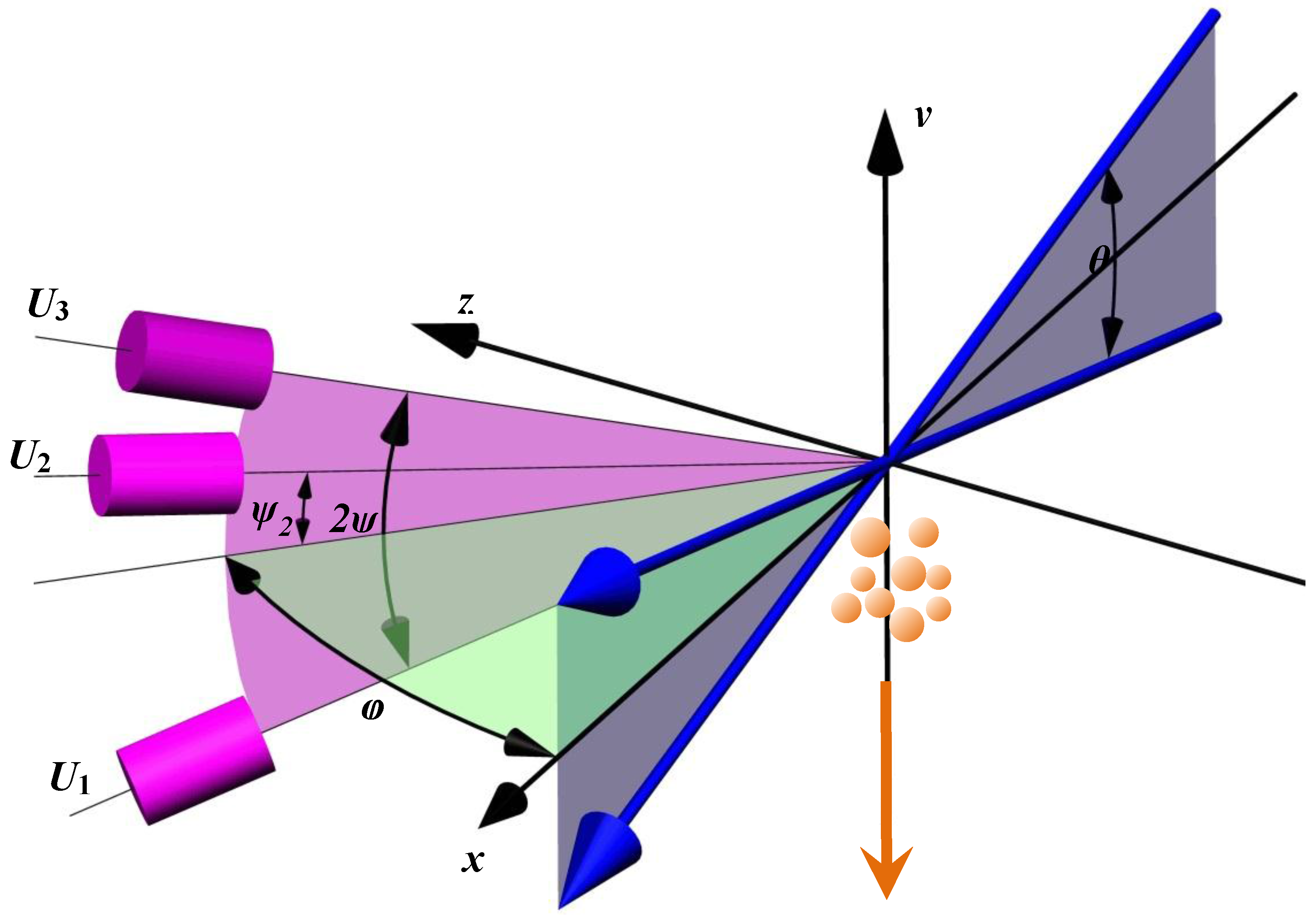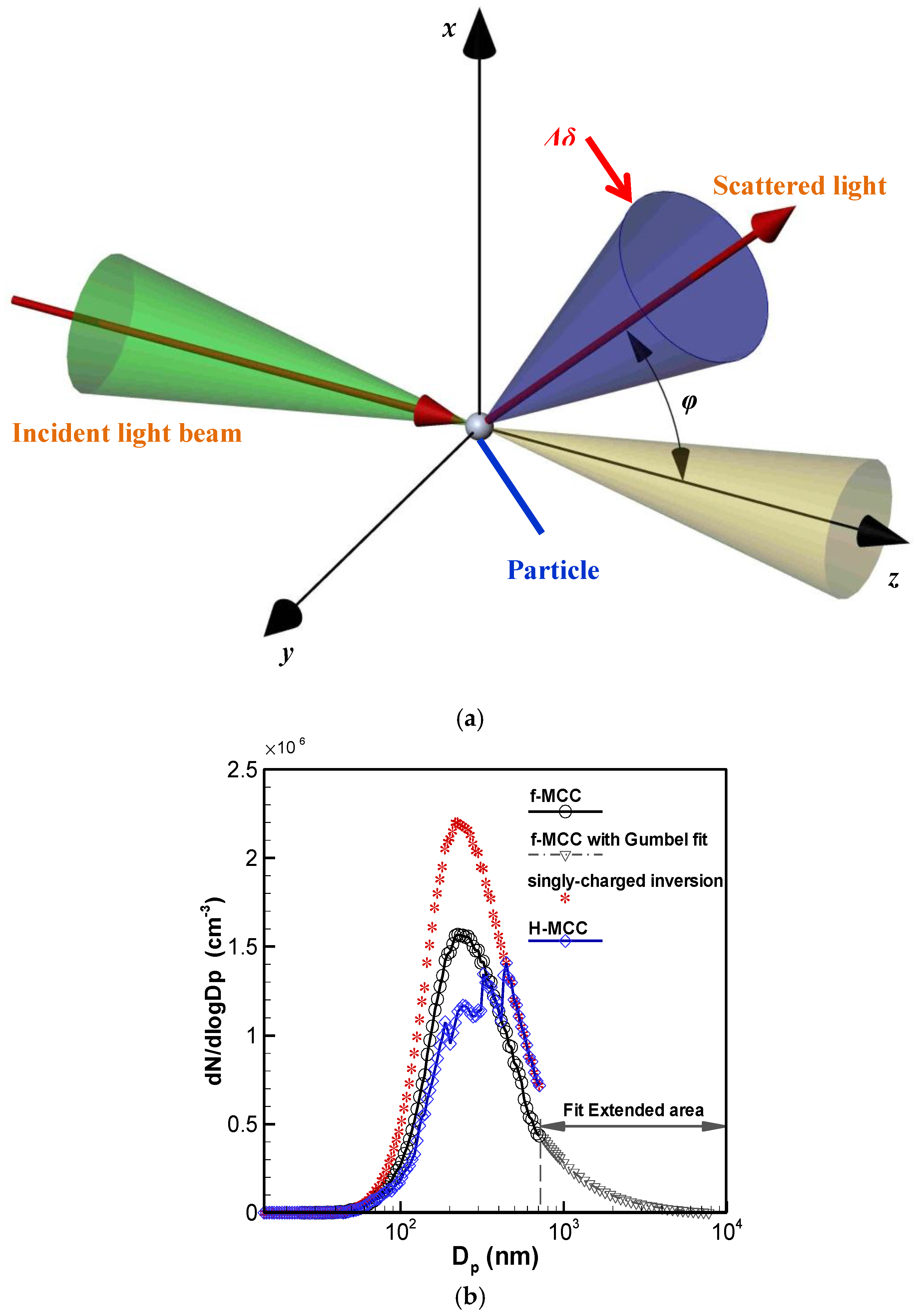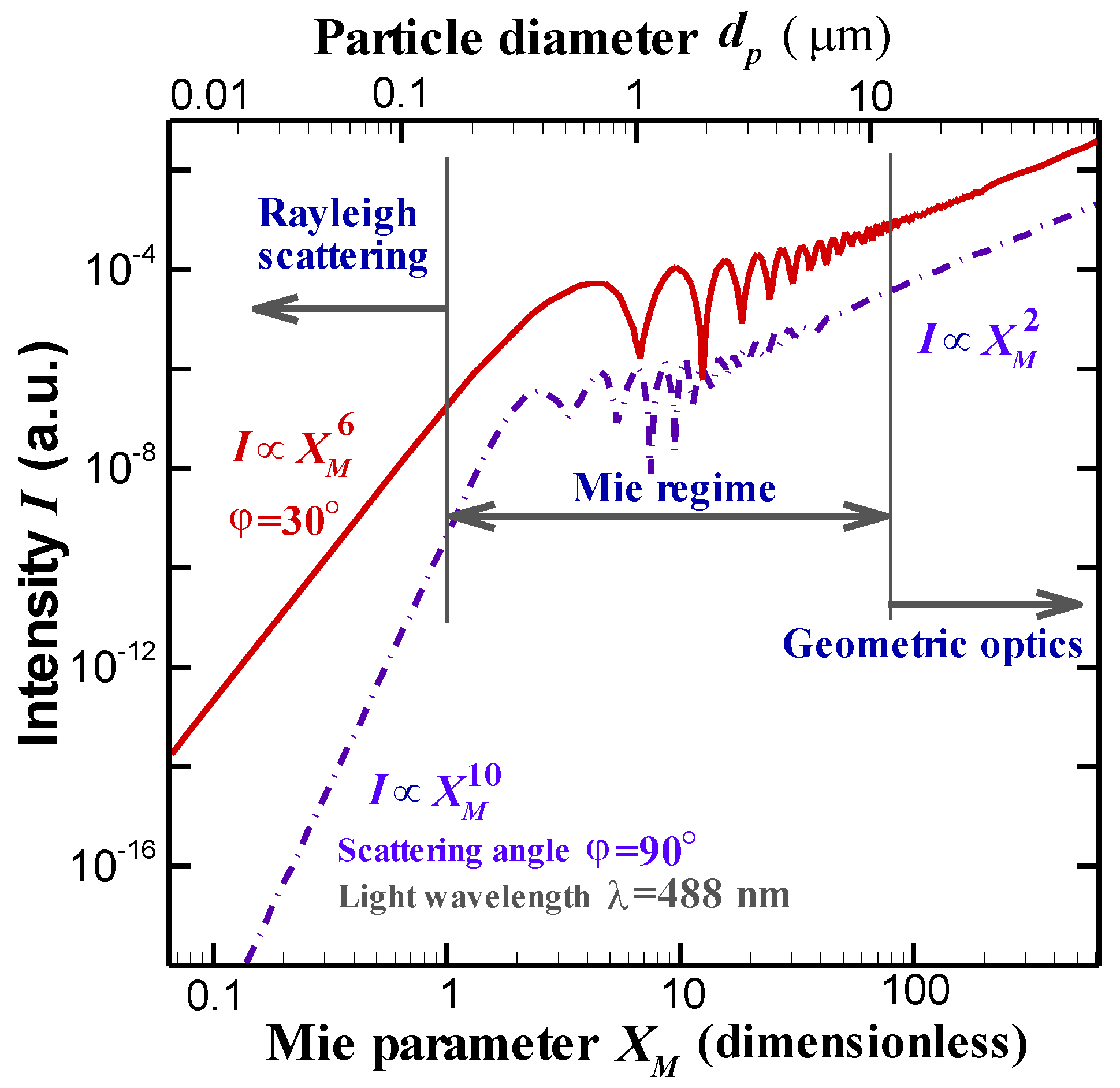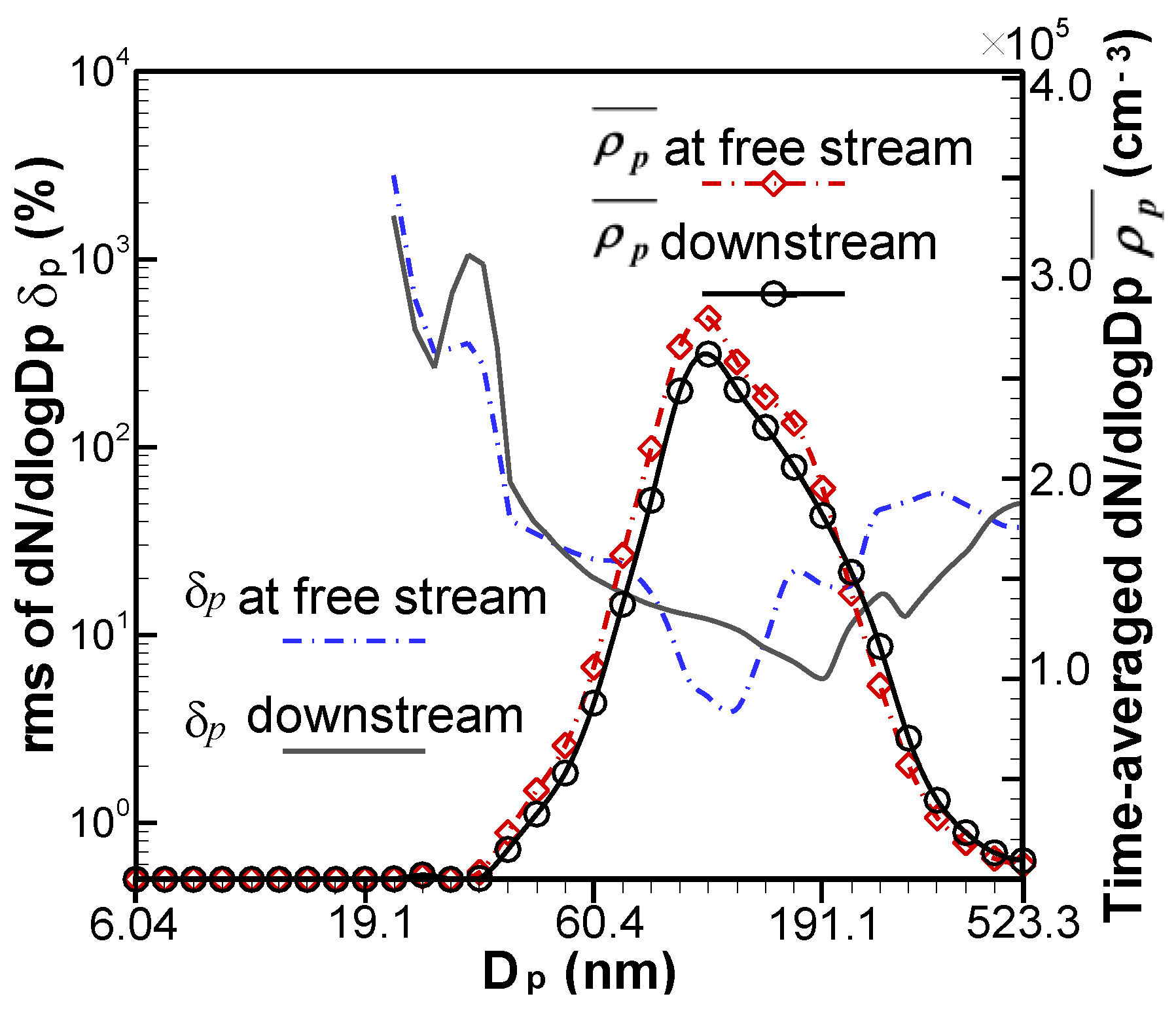The most important measurement methods for micro- to larger particle-laden gas flows versus nano- to sub-micro-particle-laden gas flows are outlined in this section.
3.1. Optical Particle Characterization
One of the most important experimental characterization methods for microparticles (or larger particles of the continuum regime) is optical analysis. Optical analysis is especially popular in two-phase flow experiments, because it is carried out as a non-intrusive on-line test, for example PIV, LDA or light-scattering techniques. At first, optical analysis was only used to measure particle velocity and number density. Now, it can analyze particle size distribution (PSD) using new laser technology, such as the phase Doppler particle analyzer (PDPA). Such techniques measure particle temperature, shape and chemical components. In spite of such recent developments, one of the ongoing challenges of such advanced measurement technologies is to assess their measurement uncertainty. The four steps involved in particle characterization using optical analysis techniques are summarized by Tropea et al. in
Figure 3 [
8].
The main optical particle characterization techniques are comprehensively classified according to their measurement principles and measured quantities in Tropea et al. [
8] and summarized here in
Table 1. The measurement techniques listed here only cover techniques for particles larger than 500 microns (within the continuum regime or partly overlapping with the transition regime). Typically, both elastic scattering and inelastic scattering are used for optical particle characterization. Elastic scattering is used to detect particle size and velocity, while inelastic scattering is used to measure particle temperature, density and chemical species.
In particle-laden gas flows, the relative velocity between particles and the carrier phase affects the particle concentration distribution and flux density, as well as the interphase transfer of mass and heat. This indicates that velocity measurement of both phases is indispensable. The velocity of the dispersed phase and the carrier phase can be acquired optically, either as a pointwise measurement, such as with an LDA [
9], or as a field measurement, such as with PIV/PTV [
3,
10]. The relative velocity between phases depends not only on the particle velocity, but also on the velocity of the carrier phase. This suggests that the velocity of the tracer particle used to deduce the carrier phase velocity and the velocity of the dispersed particle should be measured simultaneously. There are two effective solutions to this problem: (i) using a scattering light signal from the tracer and dispersed particle of a different wavelength; or (ii) ensuring there is a large size difference between the tracer and dispersed particle.
3.1.1. Particle Image Velocimetry
PIV is a non-intrusive measurement technique for determining the instantaneous flow field, based on a pair of time-correlated particle images having a short time lag of several to hundreds of microseconds. PIV is able to measure the velocity field, as well as other measurable quantities in real time, such as particle concentration distribution and temperature. Thus, PIV has been widely applied to fields as diverse as aerospace propulsion, biomedicine, aeronautics and micro-electromechanical systems (MEMS). During a typical PIV measurement, the tracer particles are first broadcast into the fluid and excited by a laser pulse, so that the scattered light from these particles is recorded using a CCD. The laser pulse and the CCD are triggered synchronously. Pairs of particle images are shot at short time intervals. The particles’ shifts can be calculated using cross-correlation or self-correlation, while the velocity vector of the interrogation window is calculated by averaging the entire particles’ shifts within the image area. Finally, a velocity field is reconstructed, after determining all velocity vectors.
Figure 4 outlines the steps involved in the PIV technique.
In the early 1980s, it was shown by Meynart [
11] that PIV could be used for the measurement of flow fields. Over the last 20 years, techniques using analog image acquisition and post-processing have been gradually replaced by techniques using digital image capture, such as CCD [
3]. Because PIV is popular for fluid mechanical studies, there are abundant reviews on the various advances in PIV, outlined in
Table 2.
The references covered in each of these reviews total more than 100, and there are more than 1200 references on PIV published from 1917 to 1995 collated by Adrian. The major technical advances over the last 30 years for this technique were presented by Raffel et al. [
3], as shown in
Figure 5. Most recently, high-time resolution PIV and holographic PIV methods have been commercialized, supported by CMOS cameras and high-repetition rate Nd:YAG and Nd:YLF lasers.
The measurement of instantaneous velocity fields using PIV, effectively pushed forward research on unsteady flow, with PIV results able to directly verify the numerical results of computational fluid dynamics. Since its appearance, PIV has gradually displaced LDA, because it is able to examine the velocity of both the dispersed and carrier phases. At low particle concentrations, a normal laser is sufficient to scatter light from relatively large particles in the continuum regime, and high-contrast particle images can be captured using a basic camera. In cases with high particle concentrations or large imaging areas, there are probably several particles in each interrogation area, making conventional digital cross-correlation PIV quite practical. If particle concentration is so low that each interrogation area only includes one particle, then PTV can be used to explore the particle trajectory and velocity using a Lagrangian approach. It is difficult to measure the velocity of the carrier phase using PIV, where there is interruption of the dispersed phase, as is the case for LDA. Examples of simultaneous measurement of two-phase flow using PIV are described in detail in Kiger and Pan [
19] and Khalitov and Longmire [
20]. Usually, it is possible to distinguish the dispersed-phase particles from tracer particles using obvious differences in size and luminosity, especially when the tracer particle is small enough [
19,
21]. However, some issues exist; for example, when tracer particles are in shadows behind extremely large particles, the camera does not capture them. Based on a technique proposed by Sakakibara [
21], Paris and Eaton [
22] used a low signal threshold to eliminate noise from the images and an object-growing algorithm to reduce halo effects around particles; thus, larger particles were more easily identified. Measuring the carrier-phase velocity very close to the particle surface is still one of the most difficult issues in experimental studies. This is because tracer particle images near the particle surfaces are usually eliminated as image noise. Tanaka and Eaton [
23] adopted a very-high resolution PIV system, with an image area of only 3.7 mm × 4.7 mm to mitigate this problem. Theoretically, phase discrimination based only on particle image size causes errors related to zero crosstalk. Despite this improvement, the measurement area was so small that hundreds of particle image pairs were required to achieve adequate turbulence statistics.
In short, high-spatial resolution PIV techniques are the most effective experimental method for particle-laden flows with low volumetric concentrations, while high-time resolution PIV and holographic PIV techniques show great potential for turbulence analysis and three-dimensional pressure field reconstructions. However, ongoing technological progress is required, before robust testing technologies are developed [
24]. In reality, micro-PIV still fails to measure microscale gas flows accurately; thus, it has a long way to go before reliable measurements can be acquired for microparticle-laden gas flows.
3.1.2. Laser Doppler Anemometry and the Phase Doppler Analyzer
As with PIV, LDA is a non-intrusive online measurement technique, with pointwise detection based on light interference. In LDA measurements, two laser beams having similar wavelengths are induced to a focus, forming a small measurement volume. A slight frequency shift generated using a Bragg cell results in interference fringes near this focus. The interference of the two laser beams leads to alternate bright-dark fringes, reflecting the intensity modulation. These fringes are parallel to the angular bisector of the incident laser beams. According to the plane wave theory, the width of these interference fringes is given by:
where
d is the interference fringe width,
λ is the wavelength of the incident laser beams and
θ is the angle between the two incident beams. As a tracer particle crosses these fringes, the scattered light intensity is strongest in the bright fringes and weakest in the dark fringes. This light scattering is measured, producing a modulation signal with a Doppler shift, which is directly proportional to the particle velocity component perpendicular to the angular bisector of the incident beams, as described in Equations (4) and (5).
where
fD is the Doppler shift,
t is the transition time to cross a fringe and
Up is the particle velocity component perpendicular to the angular bisector of the incident beams. Photomultipliers transform the fluctuations in the scattering intensity into an electrical signal of Doppler pulses. This signal is filtered and amplified using a signal processor, and the Doppler shift is obtained from spectral analysis of the processed digital signal using FFT, as shown in
Figure 6. Therefore, the particle velocity component can be calculated using Equation (5). Similarly, two other velocity components can be measured using supplementary laser beam pairs of different wavelength. The scattering intensity distribution for a spherical particle predicts that the photodetector would receive the most powerful scattering signal when placed in front of the incident beams, with a 0° scattering angle. An LDA system with this configuration is called a forward LDA, whereas a backward LDA has the incident laser and photodetector on the side having the weakest signal.
The principle of the LDA may be described in the other way using the Doppler effect, which indicates the change in frequency or wavelength of sound or light for an observer moving relative to its emitter. In LDA, a moving particle receives the plane light waves, which are emitted from laser beams, and transmits them to the stationary photodetectors simultaneously. This process leads to an additional Doppler shift when the scattered light is received from a stationary observer. Then, the frequency of light received at the photodetector can be given by:
where
fe is the frequency of the laser source,
is the velocity of the moving particle,
c is the velocity of the light and
and
are unit vectors in the direction of the incident light and the direction of the light transmitted from the particle to the receiver.
The frequency shift
fD resulting from the scattered lights, which are obtained from two incident beams, can be expressed as:
Using Equation (6) and the velocity components in the directions of the two laser beams with,
Equation (5) is obtained again [
1].
LDA has been employed to measure two-phase particle-laden gas flows for several decades. As the dispersed particles obviously need to be larger than the tracer particles, the particle scattering intensity and Doppler pulses generated also are much stronger; thus, it is very easy to measure particle velocity using LDA. In contrast, the Doppler pulses generated by the tracers are much weaker, and a phase-discrimination of the Doppler signal must be carried out to ensure the reliability of two-phase measurements. In the continuum regime, LDA seems to be the most viable option at present, given that most dispersed particles have a size range of 10 to 1000 μm, and tracer particles are approximately 1 μm sized.
The PDA was first proposed in 1981 [
25,
26,
27,
28] as a derivative of LDA. The PDA is able to simultaneously measure spherical or quasi-spherical particle velocity and size. It has been developed into a very reliable technique for these quantities. In LDA measurements, if several detectors are used to examine the Doppler shift, then the shift signals simultaneously acquired by these detectors are similar, although there are phase-differences between them that are proportional to particle size, as shown in
Figure 7. Taking into consideration only first-order refraction, the correlation between the phase-difference and particle size is equal to:
where ΔΦ
(p = 2) is the phase-difference between fringes on the two detectors, placed at elevation angles ±
ψ and off-axis scattering angles of ±
φ;
m is the ratio (relative refractive index) of refractive indexes between the particle and the carrier phase; and
v is a parameter function, described by:
A proportional relationship between the measured phase difference and particle diameter was found to be affected by the proportionality constant, involving geometric quantities [
8]. Thus, the PDA technique is usually considered to be calibration free and in situ traceable, although its overall accuracy depends on the precision of the angles, as seen in Equation (8). The PDA is most suitable for measuring liquid and transparent droplet diameter and velocity, because first-order refractive light is often the target signal in PDA measurements. However, spherical transparent solid particles also can be measured using PDA, and even opaque spherical particles can be discriminated, using reflective light as the target signal.
Phase-Doppler techniques use a full-featured instrument that detects particles down to 300 nm in diameter (based on the detector sensitivity), for concentrations ranging from 10
4 to 10
5 particles/cm
3. When particle size is larger than the measurement volume, it is difficult to discriminate first-order refractive light from reflective light, because of mixing. Hence, any determination of particle size directly calculated from the Doppler phase difference would result in significant error. Saffmann [
29] first observed this phenomenon, although this Gaussian beam effect/defect has been studied by other authors [
30,
31,
32]. A number of studies have focused on reducing this error to increase the viable particle concentration range [
30,
33].
3.1.3. Scattering Intensity Measurements
Particle characterization (e.g., particle size and concentration) using scattering intensity measurements is a long-standing technology for multiphase flow, which was well known and widely used before the emergence of either LDA/PDA or PIV. Recently, scattering intensity measurements combined with laser or fluorescence illumination have extended the particle characteristics able to be detected in this technique, e.g., particle velocity [
34,
35], temperature [
36,
37] and chemical species [
38]. It is used not only to detect micro- or larger particles, but also to measure nano-particle concentrations, e.g., in condensation particle counters, and a practical result obtained using this technique is shown in
Figure 8b. The optical principles behind scattering intensity measurements are shown in
Figure 8a. The signal received from the optical measurement system is usually equal to the integral of the scattering intensity on the receiving aperture of the optical sensor. In this case,
φ is the scattering angle (the receiving angle of the photoelectric detection system), and Δ
δ is the receiving solid aperture angle. Under parallel and monochromatic light, with a scattering angle
φ, the scattering intensity is equal to:
where
Q is the scattering intensity received by the detector,
κ and
m0 are the particle complex refractive index coefficients and
I0 is the incident light intensity. This equation indicates that the scattering intensity depends on the optical arrangement constants, as well as the particle refractive index.
There are three fundamental scattering mechanisms for a water droplet in air: Rayleigh scattering, Mie scattering and geometric optics, depending on the particle size and its related scattering intensity, as shown in
Figure 9. Here,
XM is the Mie parameter
XM =
dpπ/
λ, which is equivalent to the dimensionless particle diameter for Mie scattering, for parallel polarized light and complex refractive index
m = 1.333 +
i0.313. This relationship indicates that particle scattering intensity is basically proportional to the dimensionless particle diameter (
XM) for Rayleigh scattering and geometric optics. This yields values of
and
for scattering angles of 30° and 90°, respectively, under Rayleigh scattering; but
for both scattering angles under geometric optics. This linear relationship is critical for determining particle diameter from scattering intensity measurements, although it is difficult to do this for Mie scattering, because of its non-monotonic and highly fluctuating relationship between
XM and
I. However, there are modifications available to deal with this problem, such as expanding the receiving aperture area, using a white light source or setting the scattering angle to 0° to smooth Mie scattering, as particle size increases [
1]. For
, the particle scattering intensity is strongest at a 0° scattering angle, because diffracted light is dominant, compared with the other two scattered light components (externally-reflected and internally-refracted light), and is highly concentrated in a forward scattering direction. This regime of geometrical optics is termed the Fraunhofer diffraction regime. In this regime, the particle scattering intensity only depends on the incident light wavelength and particle size; thus, increases in particle size decrease the angular range of the diffracted light. In this case, the diffracted light intensity is independent of the optical constants of the particle material and may be used to measure particles of different or undetermined refractive indices. In contrast to a 0° scattering angle, a scattering angle of 90° usually produces the weakest scattered light and receiving light signal. However, in practice, limited operating space and the requirement of non-intrusive detection usually results in setups having
. Given that there should be only one particle in the measurement volume to avoid significantly overestimating particle size, this determines the upper concentration limit of the scattering intensity techniques. There are two ways to solve this problem: (1) use a microparticle-laden gas flow with particles smaller than the measurement volume, which can be generated using a micro-mechanical device, e.g., a particle-laden micro-jet flow in a particle counter, although this involves a sampling stage; and (2) use an optical arrangement that achieves a small enough measurement volume, which can be carried out online.
Other parameters, such as tracer particles and blockages of incident light or scattered light, also have a marked effect on particle characterization using scattering intensity measurements. It is important to note that scattering intensity measurement techniques inevitably fail to characterize particles in the Mie scattering regime, because of their non-monotonic relationship with dimensionless diameter
XM and scattering intensity
I. Mie/laser-induced fluorescence (LIF) ratio technology was specifically developed to overcome this problem [
40,
41,
42,
43]. In this technique, the ratio of fluorescence intensity to scattered light is used as an analog signal to replace the conventional scattering intensity. Using fluorescent tracers, it is presumed that fluorescence intensity is proportional to droplet volume (
dp3), while Mie scattering intensity is proportional to
dp2; thus, the intensity of fluorescence and Mie scattering can be distinguished according to their varied wavelengths, and particle size can be estimated using their intensity ratio. This method has reduced the influence of other parameters on the detection, but leads to a dependence on particle size and fluorescent concentration, as well as any related calibration. Currently, only droplets can be characterized using Mie/LIF ratio measurements, since there are still several unresolved issues for measuring solid particles and non-spherical particles.
3.1.4. Laser-Induced Fluorescence Techniques for Temperature and Composition Measurements
LIF is derived from a process that begins with the absorption of the incident light by the fluorescent molecules, which are activated to a higher energy level. Some of the excited molecules return to the ground state by emitting fluorescence. As one of the most important inelastic scattering techniques, laser-induced fluorescence (LIF) is also used to measure particle temperature [
36] and composition [
38]. The basic principle behind such techniques rests on the temperature or molar fraction dependence of the fluorescence quantum yield.
The fluorescence intensity detected on a spectral band from a droplet, which is previously seeded with a low concentration fluorescent tracer, is given by [
36]:
where f denotes the fluorescence,
i denotes the spectral band,
Kopt is an optical constant specific to the optical device,
Kspec is a constant that depends solely on the spectroscopic properties of the fluorescent tracer in its environment,
I0 is the laser excitation intensity,
C is the molecular tracer concentration,
T is the absolute temperature,
VC is the collection volume of the fluorescence photons,
β(
λ) describes the temperature dependence of the fluorescence intensity at the wavelength
λ and
a and
b are the temperature sensitivity coefficients for the spectral band
i. However, the
I0,
VC and
C are strongly dependent on the droplet size, droplet position and on the probe volume dimensions. In order to address these problems, Lavieille et al. determine the fluorescence intensity on two spectral bands (called two-band LIF) for which the temperature sensitivity is significantly different, and the selection of these spectral bands is optimized. Then, the temperature can be calculated from the fluorescence ratio between both fluorescence intensities collected on both optimal spectral bands [
36]:
Mean droplet temperature and velocity evolution in the flame as a function of time are plotted in
Figure 10 [
36].
The fluorescence quantum yield
g should rely on the liquid phase composition (i.e., fluorescent tracer fraction and temperature). However, Maqua et al. showed that the variation of
g is almost negligible in the temperature range of the liquid phase [
38]. Consequently, the total emitted fluorescence can be used to detect the number of molecules of the fluorescing component in a droplet, and the relation between the fluorescence signal and molar fraction of fluorescent tracer
χa (i.e., acetone), which is strongly related to
g, can be expressed by:
where
Il is the local intensity, which can be related to the laser incident intensity
I0 by Beer’s absorption law, d
V is an elementary volume and
μ is a dimensionless empirical constant, which can be properly calibrated in the experimental procedure.
3.2. Experimental Methods for Sub-micro- and Nano-particle Laden Gas Flow
Submicron- and nanometer-sized particle-laden gas flows are a common phenomenon in nature and also have been widely studied in the context of many engineering problems, including advanced nanomaterial manufacture, engineering thermophysics, chemical engineering, inhalation toxicology, medical and pharmaceutical manufacturing [
44,
45,
46,
47]. Thus, it is very important to study sub-micro- and nano-particle-laden flows to provide theory, models or measurement techniques for these engineering problems. As described above, the scattering ranges of sub-micro- and nano-particles are mainly within the Rayleigh and Mie scattering regime, in which particle scattering intensity is so weak that light signals cannot be reliably acquired by current apparatuses. However, scanning electron microscopy (SEM) and transmission electron microscopy (TEM) can capture the sub-micro- and nano-particle morphology, as they are sampled on substrates (e.g., holey carbon support films). Moreover, the very slight inertia of submicron- and nanometer-sized particles results in the invalidation of particle sieving, using mechanical or aerodynamic methods. The measurement techniques for nano-particles usually require sampling, and to date, no online technique (e.g., for measuring nano-particle velocity) has emerged. It is important to note that the particle diameter acquired using present nano-particle sizers is either an aerodynamic or an electrical mobility diameter; in which case, the electrical mobility diameter of a real spherical or non-spherical test particle is the mobility-equivalent diameter of an ideal spherical particle. Likewise, the aerodynamic diameter of a test particle is the inertia- and settling-velocity-equivalent diameter of an ideal spherical particle in air, with a density of 1000 kg/m
3. Nano-particles are fantastic tracers, even in the supersonic and hypersonic boundary layer, because of their small size and inertia. Yi et al. [
48] used nano-particle tracers in optical flow methods to study compressible turbulence structures at high temporal-spatial resolution. However, this comprehensive technology merely estimates the ensemble-average characteristics of nano-particles, but not its single particle ones.
An SMPS or scanning electrical mobility spectrometer (SEMS) [
49], FMPS and electrical low pressure impactor (ELPI) are three of the most widely-used commercial measuring instruments used to characterize the concentration and distribution of submicron- and nanometer-sized particles, especially for studying aerosols and particle-laden flows [
47,
50,
51]. A general particle size distribution measured using FMPS is presented in the
Figure 11, while the practical results of SMPS are shown in
Figure 8. Both SMPS and FMPS characterize particle size depending on the mobility of a charged particle passing through a cylindrical electric field. In an SMPS, sampled particles are first neutralized using a bipolar charger (e.g., Kr85 or soft X-ray) in a neutralizer to attain a well-defined steady-state distribution of positively- and negatively charged-particles [
2,
52,
53]. In contrast, particles in a FMPS are successively charged, using a negative and a positive unipolar corona charger to achieve a predictable charge distribution. A theoretical model to describe the particle charge distribution in an SMPS neutralizer was proposed by Wiedensohler [
52], which is based on an approximation of Fuchs’ diffusion theory for submicron- and nanometer-sized particles [
2]. The fractions of particles carrying different amounts of charge, according to this model, are given by:
under the conditions of 1 nm ≤
Dp ≤ 1000 nm,
N = −1, 0, 1; or 20 nm ≤
Dp ≤ 1000 nm,
N = −2, +2; and:
for the fraction of particles carrying three or more charges.
Here,
N is the number of elementary charges on a particle;
ai is a coefficient related to
N;
T is the temperature; and all other physical constants are listed in
Table 3.
The sampled particles are classified according to their differential electrical mobility in both the SMPS and the FMPS or their characteristic aerodynamic diameter in the ELPI. Because particle density clearly has a huge influence on ELPI measurements, particle density needs to be known to use this technique.
The DMA in a SMPS, used to classify the particles, usually consists of two cylindrical electrodes made of polished stainless steel [
54], in which the resulting drag force on the charged particle can quickly increase and become equal to the electrical force. According to the Stokes law, the neutralized particles following a steady-state charge distribution will achieve different terminal velocities related to their experience of the electrical force and the drag force in the annular electrical field. This produces a specific electrical mobility in the particle that determines whether it meets the conditions outlined in Equation (16) and enters the DMA, as the presupposed particle size to be measured.
where
dp is the particle electrical mobility equivalent diameter,
qsh is given by
qsh = (
Qsh +
Qex)/2,
Qsh is the sheath air flow rate,
Qex is the excess flow rate,
V is the average voltage on the inner central rod,
L is the length between the exit slit and the polydisperse aerosol inlet,
R1 is the inner radius of the annular space,
R2 is the outer radius of the annular space,
Cc is Cunningham slip correction and
μ is the gas dynamic viscosity. Equation (16) also indicates that monodisperse particles of a defined diameter can be attained by accurately adjusting
V. These monodisperse aerosols are transported into a concentration detector, e.g., a concentration particle counter [
55] or electrometer [
56,
57], to characterize particle concentration. It usually takes an SMPS several minutes to analyze each size distribution, with sizes ranging from 2.5 nm to 1000 nm, because it needs to scan through all size channels. The size resolution of an SMPS has increased to cover up to 64 channels, making its size resolution one of the highest among these three techniques.
In contrast to an SMPS, the outer cylinder in an FMPS classifier is divided into several electrically isolated segments, which are monitored using individual electrometers [
58]. Particles in well-defined charge states will collide against the outer cylinder at different electrometers, based on their electrical mobility, i.e., particles of lower electrical mobility will collide against electrometers closer to the outlet than ones with higher mobility. Hence, the current received by each electrometer can be used to reconstruct the number size distribution of the sampled particles. An FMPS does not need to scan through various voltages; hence, it has a time resolution of about 1 s for each size distribution in the size range of 5 nm to 560 nm.
Similar to an FMPS, particles in an ELPI are first charged in a unipolar charger. However, unlike the SMPS and the FMPS, the ELPI [
59] classifies sampled particles using a cascade low-pressure impactor, which is connected to individual electrometers. Particles impacting on a collection plate are deposited on the plate; thus, the charges on the plates generate currents related to their particle concentration. Both size and time resolutions of the ELPI are close to the FMPS, with a size resolution based on 14 channels and a time resolution of about 1 s. Moreover, it can measure high-temperature aerosols and is most commonly used in energy engineering for particles having a size range of 6 to 10 μm.
Both Lee et al. [
60] and Christof et al. [
61] found that particle size distributions (PSDs) acquired using an FMPS show a clear negative deviation from those acquired with an SMPS, although there is a strong linear relationship between these techniques. Lee et al. [
58] further demonstrated that PSDs measured using various SMPSs are consistent and proposed a correction expression for PSDs detected using an FMPS. High repeatability and consistency of SMPS led to its wide application in aerosol science and various industrial processes. It has been designated a standard meteorology technique for nano-aerosol measurements in many countries. A more detailed analysis of nano-particle measurement techniques can be found in Prashant et al. [
61,
62].
